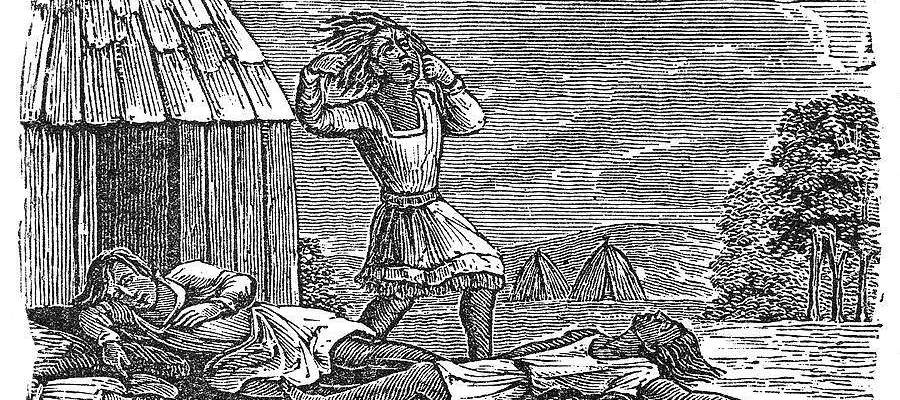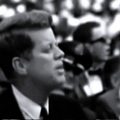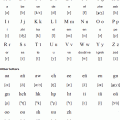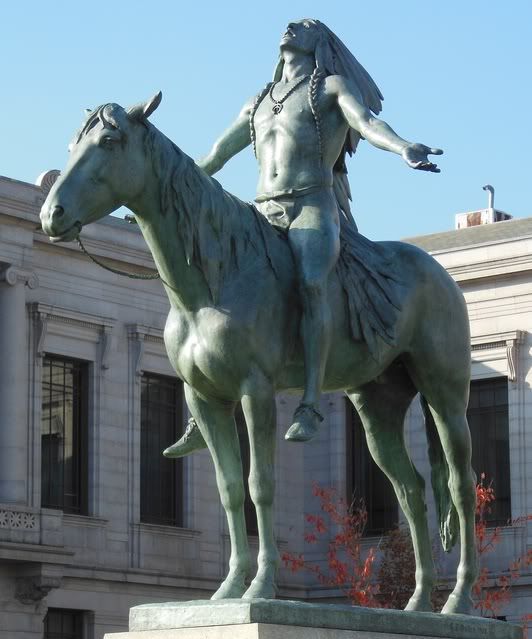
During the first part of the seventeenth century, the European invasion of North America was making the transition from exploration to colonization and exploitation. In his book Laboring in the Fields of the Lord: Spanish Missions and Southeastern Indians , archaeologist Jerald Milanich describes the reasons for the European expansion:
“The driving force behind these initiatives was a desire for wealth: precious stones or metals, fertile lands suitable for productive plantations, human populations to be sold into slavery, and animals and plants that could be hunted or harvested and exported.”
Briefly described below are some of the Indian events of 1616.
Pocahontas:
One of the few Indian women whose name is known to most Americans is Pocahontas, a Powhatan woman. In 1616, the English colonist John Rolfe took Pocahontas to England where she was used as a part of the Virginia Company’s campaign to gain support for their American colonies. In his book Lies My Teacher Told Me: Everything Your American History Textbook Got Wrong, historian James W. Loewen points out:
“Pocahontas stands as the first and almost the last Native to be accepted into British-American society, which we may therefore call ‘white society’, through marriage.”
He goes on to point out that after Pocahontas interracial couples are accepted in Native society, but not in Anglo society.
Guns:
One of the items of European technology which provided Europeans with military superiority was the gun. In 1616, the English instructed some Powhatan warriors in the use of the new snaphance muskets which used a flint on steel ignition. According to historian Ian Steele, in his book Warpaths: Invasions of North America:
“This musket instruction was Opechancanough’s price for allowing any Christian instruction.”
Opechancanough, who was probably Pocahontas’ uncle, was one of the important Native leaders at this time.
Conflict:
The English colonists in Jamestown, Virginia found that their food crops were low because they had been energetically promoting the raising of tobacco instead of food crops. They sent for their annual tribute of corn from the Chickahominy. The Indians claimed that they had already paid the tribute. The next day, the English opened fire and killed 20-40 Indians.
The English were unaware of the fact that they had been manipulated into this incident by Opechancanough who had advised the Chickahominy to resist the English demands and who had told the English that the Chickahominy were killing English cattle and swine.
Epidemics:
As contact with the Europeans intensified, so did the diseases which they brought with them. These diseases—smallpox, cholera, influenza, measles, and others—were new to the Indian populations.
The first of three epidemics struck the Indians of New England. It is estimated that 75% of the population died between 1616 and 1619. The epidemics swept from Cape Cod to the Kennebec River in Maine. The epidemics started after an English party wintered at the mouth of the Saco River.
It is estimated that prior to the epidemics, there were 24,000 people living in Indian communities affiliated with the Wampanoag confederacy led by Massasoit.
In Massachusetts, the Massachusett were nearly exterminated.
It is not known what the actual disease was that caused this epidemic. Various writers have suggested bubonic plague, smallpox, and hepatitis A. There is strong evidence supporting all of these theories.
Spanish Mission:
In Georgia, the Spanish mission Santa Isabel de Utinahica was serving the Timucua.
Alliance:
In Florida, Timucua chief Enecape gained control of the villages which had been in an alliance under chief Outina. Archaeologist Jerald Milanich, in his book Laboring in the Fields of the Lord: Spanish Missions and Southeastern Indians, reports:
“This power shift was probably a result of disease-related population decimation in the northern sector of the alliance, that portion closest to the sixteenth century European settlements at St. Augustine and Ft. Caroline.”
The Spanish sometimes referred to this alliance as the Agua Dulce (Sweet Water) Indians.




Leave a Reply